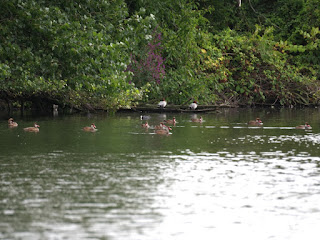A Mute Swan came down on the Serpentine and waterskied to a halt.
A pair of swans were preening on the Serpentine. Swans have the most feathers of any bird, in some species as many as 25,000, and these need constant attention.
One of the young Great Crested Grebes from the island was exercising a pair of quite well developed wings. It will be able to fly soon. Grebes have small wings for their size and need to fly at high speed to stay up, which is why their takeoff run is such a long and frantic affair.
The Moorhen chicks at the bridge are finding most of their own food, but are always pleased to accept something from a parent.
A Blue Tit in the Rose Garden had found some small white larvae on a twig, and was devouring them.
A Dunnock had also found a small white object, probably a seed from the bird feeder spilt by the enthusiastic rummaging of the tits. Dunnocks never seem to go on the feeder, and are almost always seen on the ground.
The racing pigeon, not seen for a few days, was also back under the feeder.
A Blackbird had found something more substantial, a worm under the railings.
A flock of Long-Tailed Tits was working its way along the edge of the Long Water.
Starlings were playing on the weathervane of the Lido restaurant. It also provides a vantage point for raids on the outside tables.
The female Little Owl at the leaf yard looked down from her new favourite branch.
There was a stand of mushrooms in the patch of scrub east of the Albert Memorial Little Owl tree. They looked like Blushers, Amanita rubescens, which are edible and good, and like Blushers, they stained dull red when bruised (hence the name). But they lacked the noticeable ring and volva (sheath at base) of an Amanita species, so I left them alone. Even with the real Blusher you have to be very careful, as most Amanitas are poisonous and some are deadly.










Amanita phalloides is the main culprit of death by poisoning here. It looks very similar to other edible species, and even experienced mushroom hunters are sometimes deceived.
ReplyDeleteGrebe wings are one of these things that ought not to work, but does. It is such a prodigy of aerodynamics that such tiny wings should carry a medium-sized bird.
A. phalloides, the Death Cap, and A. verna, the Destroying Angel, are the two most poisonous species here, both invariably fatal and there is no antidote.
DeleteGrebes always remind me of the Lockheed F-104G Starfighter, whose tiny wings required furious takeoff and landing speeds. They were notorious for frequently crashing on both occasions. But at least a grebe can crash into the water.
Re CDs from Wednesday, the idea is to keep the gulls off and leave room for the terns to nest. The stuff is taken down when the terns come in as the gulls nest 4 - 6 weeks earlier and there would be no room for the terns to nest.
ReplyDeleteIt is indeed the very variable Amanita rubeshens. In this species the ring is thin and flimsy, and can easily disappear, as does the volva, which is really only visible in young specimens.
ReplyDeleteMario
Thank you for the identification. There are quite a few of the mushrooms in this place, which is distinguished by clumps of heather, an unusual plant in the park. When I was there, only one had been broken, and I turned it upside down for the photograph.
DeleteShould have been "rubescens"
ReplyDeleteAha, I see now.
ReplyDelete